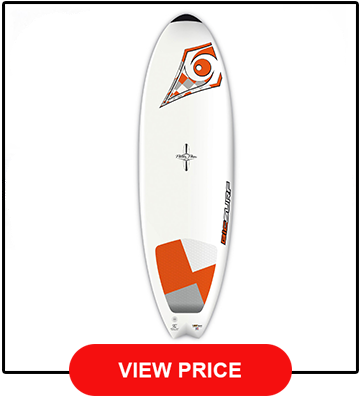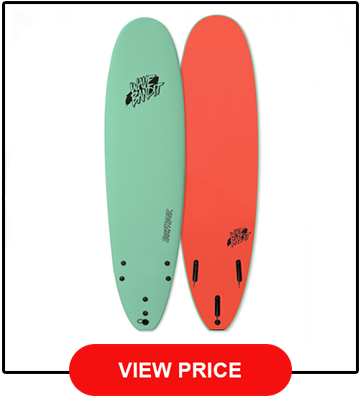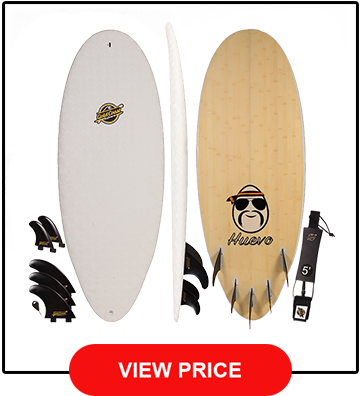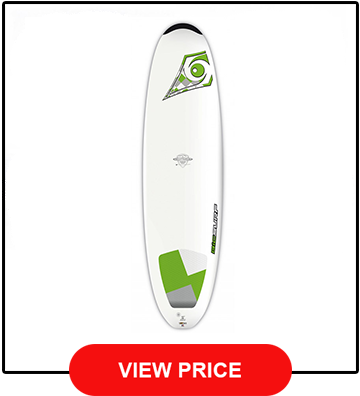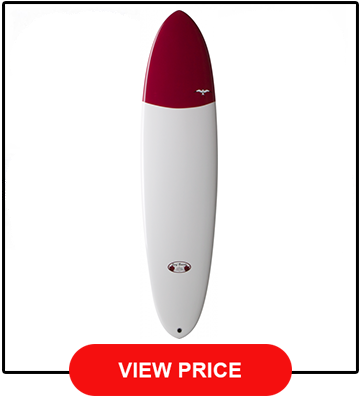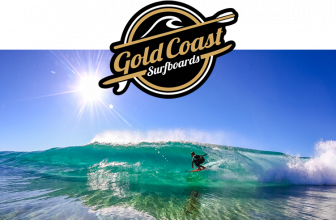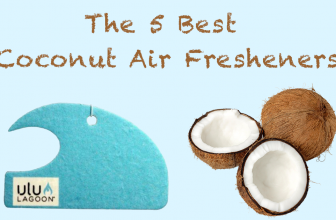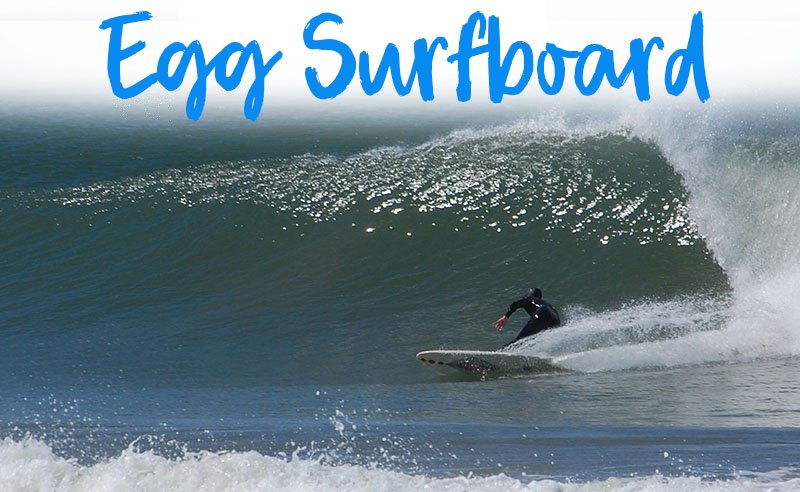
There are many reasons to add an egg surfboard to your quiver. Entry-level surfers may find it hard to retain balance on their boards, but since the egg is so wide, it gives those surfers the advantage.
More...
For intermediate surfers, it is great for mid-sized wave because of its short speed and maneuverability. It’s a well thought out type of board that takes some of the best attributes of longboards and shortboards and puts them together to create something that works for all skill levels.
Whether you’re looking to move on from something a bit less rigid than a longboard, have the desire to transition to a shortboard, or just want to have a little fun, there is an egg with your name on it.
They definitely aren’t the models of the lineup, though we have found beauty in their quirkiness and want to share it with you!
What Is An Egg Surfboard?
These are the characteristics and properties that make up an egg board:
Top 5 Best Egg Surfboards
#1 Pick - BIC Sport DURA-TEC Egg Surfboard - 5"10'
An excellent surfboard from the guys over at BIC Sport, The DURA-TEC Egg is a great contender for our favorite. It has a lot of the same qualities as a longboard, but gives you the spirit and maneuverability of a shortboard.
It’s much easier to ride all kinds of waves with this board and thrash around in the ocean. You can truly surf this board in all conditions and feel the awesome sensation of the wave beneath your feet. Maneuverability and taking off is also much easier with the tight rocker profile this board offers.
The added volume on the board makes for better buoyancy and stability too, as to combat the sketchiness of a shortboard feel. It’s honestly a great board for both starters and intermediate surfers and pretty much works best for those up to 150lbs. If you’re looking for a board that paddles well and gives you a fun, loose ride, this is the one.
#2 - Catch Surf Wave Bandit EZ Rider Egg Surfboard - 7'0"
The Wave Bandit EZ Rider from Catch Surf screams fun! It’s one of the older models in the Catch Surf lineup, but we still love it.
It does retain a lot of the qualities that we’re used to on the Catch Surf boards, such as the flat rocker and slick bottom that glides easily along the waves. The EZ Rider also features double maple wood stringers that are incredibly durable and the squaretail that brings stability to the board. The wider template makes it easier for newer riders when learning to pop up and maintain balance as they move down the line.
That is pretty much why they call it the EZ rider. It is another solid foam board from Catch Surf that can be used by beginner and intermediate surfers alike for and old-fashioned good time in the water. Because it is set up with thruster fins, more experienced riders will notice its ability to turn tightly too. Even though it is a foam board, don’t try and bring it out without waxing it up.
#3 - Gold Coast Surfboards The HUEVO Egg Surfboard - 4’10
The guys over at Gold Coast Surfboards have done it again with this little monster of a board that is perfect for wild on-shore breaks. The HUEVO Egg is much smaller than your typical egg, though you’ll find the entry level characteristics still remain strong, while the single concave to a V-exit in the tail give it better release than the eggs you might be used to. The board works great with a quad set up, as it provides the board with better balance and lift out the back.
The wide shape throughout the board makes popping up easy and balancing even easier. When you’re ready to start making those turns, you’ll find that you’re able to hit them pretty heavily. Gold Coast boards seem to always provide a smooth glide as well.
The Huevo is mostly suitable for groms who want to transition to a shorter board so that they can start making their sessions a bit more interesting. Though it is very small, it should not be underestimated in terms of strength. The bamboo layers and I-beam stringer add some much needed rigidity to the board.
It’ll also work really well in wakesurf conditions if you dare take it out. This board truly completes the Gold Coast armory and we love everything about the production and materials that they used to craft it.
#4 - BIC Sport DURA-TEC Wahine Egg Surfboard - 7'
The BIC Sport WAHINE line is awesome for a number of reasons, and the Egg has a lot of what we like to see. To start, the board just feels great. It’s not too thick like a lot of eggs, so you won’t feel like you’re wrestling with it in the ocean. They didn’t take out the width though, which makes the board very easy to paddle and pop up without sacrificing the high-performance feel.
You’ll love the board’s ability to make early entry on all kinds of waves. Keep the standard thruster fin setup and you’ll be surprised at how tight this thing turns. It’s an excellent transition to shortboards as it is not so demanding, yet still has a pretty versatile outline.
The integrated 3D traction pad gives less experienced riders less of challenge when first figuring out how to stay on top of their board. With the pink flavor on the board, BIC really wanted to market this to girls who are getting into surfing. This is probably the best egg surfboard for beginners on our list.
#5 - Surftech Takayama Egg Surfboard
Looking to step up to a true performance egg surfboard? The legend himself, Donal Takayama, designed this egg surfboard to give you the “shred” of shortboard with the “cruise” of a longboard.
The rounded tail gives surfers the ability to take on fast and hollow waves and really race down the line without the drag of the squaretail. The board just looks great too. The design is clean and classic and hard-top rather than foam.
If you’re looking for a board that can trim high on the waves and perform well in a wide range of conditions, as well as travel easily, we recommend the Takayama Egg. Plus, having a Takayama board in your quiver is pretty cred-worthy.
Pro's
Con's
Egg Surfboard Size Chart
Surfer Weight | Advanced | Intermediate | Intermediate | Beginner |
100-140lbs | < 6’6” | 6’6”-6’10” | 6’6”-7’2” | 6’10” > |
140-170lbs | <6’6” | 6’6”-6’10” | 6’6”-7’2” | 6’10” > |
170-200lbs | 6’6”-6’10” | 6’6”-7’2” | 6’10”-7’2” | 7’2”> |
200-230lbs | 6’10”-7’2” | 6’10”-7’2” | 6-10”-7’2” | 7’2”> |
230lbs + | 6’10”-7’2” | 7’2” > | 7’2” > | 7’2” > |
Frequently Asked Questions
Egg Vs Fish Surfboard
Egg surfboards are typically larger boards, as they run to about 8.’5” while fish only run to about 7’. They’re both good for small to mid-sized waves, though we think egg surfboards are much more versatile. Fish do much better in crumbly waves. The main physical difference that you’ll see between the two is that fish boards have swallowtails while eggs typically have squaretails. You’ll also usually find twin setups on fish surfboards while you’ll almost never find them on eggs. This is because eggs are built more for stability with their wider surface area.
Who is the egg surfboard best suited for?
While almost anyone can have fun on an egg board, they are truly best suited for those who are transitioning down from a longboard, aka entry-level surfers. They offer more control on smaller waves than shortboards, which make them an ideal tool to learn on. While longboards are great in giving that classic glide, it is nice to get a feel for the looseness that shortboards offer, as well as the maneuverability, without going full short. Longboards can also be difficult to manage in the water because of their sheer size, especially for young ones. This is another place where eggs come in handy. They make catching waves easy and getting your board out on the water even easier.
What kind of waves should I be going out on with my egg board?
Egg boards do some of their best work in knee to head high surf. Anything smaller than that and you’ll find very hard to control. That is usually when people begin taking out their grovelers. Anything bigger than head high and you’ll notice the rocker profiles on eggs giving out. Taking it out in clean, mid-sized rolling waves or clean summer breaks will really make the egg shine.
What fin setups work best on an egg surfboard?
This question is difficult and totally depends on your surfing style. Most eggs are bit bigger than shortboards (with some obvious exceptions), which is a primary reason that we don’t recommend putting thrusters on them. They just aren’t meant to have that same cut, which is what thruster fins are really meant for. If you’re advanced and want to work against the egg board and go for those sharp cuts, by all means go for it. This is pretty much for the beginner and intermediate riders who aren’t going to be pushing beyond the typical flow of their egg boards. Most novice and intermediate riders aren’t pumping either, another key element of a thruster, so in reality having that extra fin can cut your speed significantly.
Here’s a little breakdown. A solid single fin can give you a nice and smooth longboard-style ride. A 2+1 is incredibly versatile and is probably our favorite for the egg because of that. If your style is very aggressive or you want to pick up better speed, that is when a quad comes in handy. If you go for a thruster, we’ll assume you are really aiming for that shortboard feel.
What are the advantages of squaretails?
Squaretails are pretty much standard for longboards, and that is the reason many egg shapers have incorporated them into their boards. It is also one of the first types of tails that we ever saw on surfboards and gives any board a classic feel. The squaretail is so great for beginners as it provides a ton of stability. Because the corners aren’t rounded, you’ll find that it is also easier to dig into a wave so that you can make sharper turns. Though this isn’t as helpful on a longboard because of the size, when paired with the length of an egg, it helps make it much more maneuverable. The reason we are starting to see more experienced surfers opt out for rounded tails is that they have much better cut, especially on bigger and steeper days.
Should I get a traction pad for my surfboard?
There are many reasons why having a traction pad (like the one on the BIC DURA Tec) is a great idea. They help you take your focus off of stability and instead turn it to watching the waves. In terms of stability, a traction pad will increase your ability to hold and dig deep on the back of a board to maneuver more easily. Getting that proper stance as a beginner can be one of the most difficult things, especially when the entirety of your board feels like one big waxy floor. With a traction pad in the mix, you can let your back foot do the work and just feel out that stance instead of looking down to make sure you’re doing it right.
With all that being said, many surfers have a huge disdain for traction pads. Many complain that it can be rough if you wipe out or slip back on your board, as it can be a culprit for some pretty nasty rashes or scrapes. Other more experienced surfers prefer wax as it gives the board a “freer” feel as they move from front to back. In all, we would highly recommend picking up a traction pad. There are so many great reasons to get one, especially if you are just starting out.

